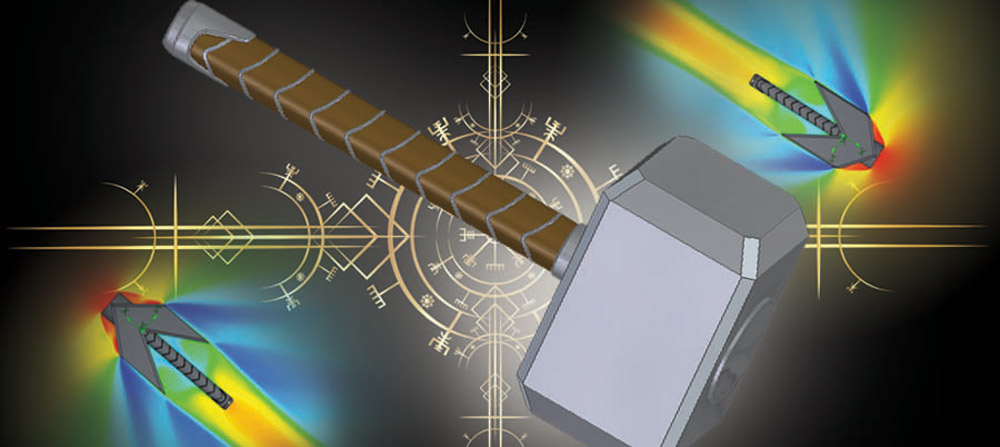BLOG ALL ABOUT IT
Did you know you don’t have to wait for the next edition of Engineer Innovation to find out about the latest exciting developments with Simcenter? Not to mention some of the more unusual projects our team have been working on.
Our blog is regularly updated with all this and more. And whilst it’s only a click away, we thought we’d give you a taster of what we’ve been talking about in recent months.
Aerodynamics to Marvel at
Let’s start with Thor’s Hammer, or Mjölnir, to give it its proper name. Marvel fans will know it was created by the dwarfs Brokk and Sindre, but is it as powerful and effective as it could be? They used years of experience and dwarven magic to make the hammer behave more like a boomerang than a brick, but they didn’t have Simcenter. Boris Marovic took a deep dive into the aerodynamics of the hammer to see if he could improve its design with all the tools at his disposal.
He used Simcenter FLOEFD and Simcenter HEEDS to model and simulate different parameters of the hammer and after two days of automated processing the software delivered some very interesting results. Could Thor’s Hammer be better? Should it be better? Head over to the blog and see for yourself.
Are flying cars for real?
Even if you haven’t seen the movie, you’ve probably heard of Back to the Future as it’s one of the most popular time travel stories ever told. Prashanth Shankara has never watched it, but that didn’t stop him from using Simcenter STAR CCM+ to analyse how Doc made his DeLorean fly and how realistic that might be.
Prasanth’s initial calculations found that the Doc’s car had the same drag coefficient as the 1979 Mercedes Benz G class. Given this is an off-road vehicle which listed No.4 on the top 10 least aerodynamic cars ever made, it seemed a pretty tall order to prove that a similar car could fly. But that didn’t stop him doing his best, and he also did an impressive job of shoehorning in quotes from a movie he’s never seen. And be sure to read to the end to find out how a Simcenter customer is making the dream of electrical flight in metropolitan areas a reality.
SimSailing the Seven Seas
Any budding sailors out there? Or have you ever wondered if, had Jack Sparrow had access to the latest technology, would his trips across the high seas have run smoother?
Wonder no more, because Romain Nicolas has shown how the new marine-related features in Simcenter Amesim 2020.2 could have got Captain Jack to his buried treasure in double quick time.
Gaming the system
If you’ve got your own gaming PC, you’ll know that cooling is one of the most crucial aspects of its design. You can splash as much cash as you like on high end processors and graphics cards, but if they’re constantly overheating it will be money poorly spent.
Baptista De Noronha simulated his own PC using Simcenter Flotherm XT in order to understand how the cooling system works, why it’s so effective, and if virtual engineering tools could help design something even more efficient.

Got your own ideas?
Feeling inspired to setup your own fun simulation? Great! We love to see all the new and inventive ways you use our software and hardware to experiment, prove theories, and expand your knowledge. And it’s a fantastic way to improve your skills when you’re between projects.
But the hardest part is often getting started. How do you settle on a project and ensure it will be both fun and worthwhile? The answer will probably be slightly different for everyone, for anyone considering taking on such a task. Have a look and see if it sparks any ideas – who knows, maybe your project could be featured in Engineer Innovation one day.
The history of the Digital Twin
Our team don’t just blog about their own work. It can be just as interesting to analyse what others have achieved or, as Stephen Ferguson did last year, investigate the history of CFD simulations.
Until Tom Hanks starred in Apollo 13 in 1995, most people were unaware of the significance of the space mission and how close it was to disaster. But now we know that the crew were all saved thanks to remarkable work and calculations carried out by the astronauts and engineers on simulators back at Mission Control.
Stephen took an in-depth look at how this was done, and questioned if, whilst this mission wasn’t the first to have a simulator on the ground, was it the first true Digital Twin? He also explained how Siemens contributed to saving electricity on the spacecraft, which ultimately was the difference between life and death.
With new posts being published every day, the blog will always have something to satisfy every curious mind. Whether it’s the new features in the latest version of a particular toolset, or expert analysis on ground-breaking work being undertaken around the world. So don’t miss out, it’s the best way to discover even more about the endless possibilities with Simcenter.
